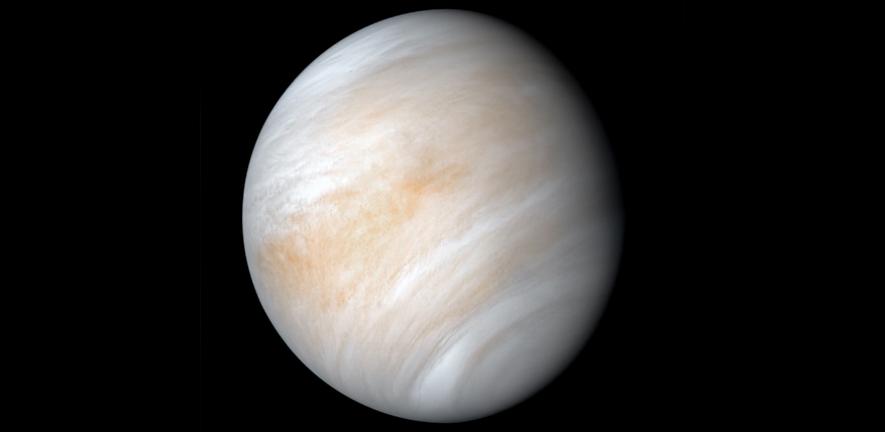The planet Venus is one of the most inexplainable and mysterious planetary objects in our solar system as its surface is beyond inhospitable for us fragile humans with temperatures at a searing 475 degrees Celsius (900 degrees Fahrenheit) and surface pressures more than 90 times that of Earth. However, its atmosphere is quite a different story as its temperature varies considerably ranging from -143 degrees Celsius (-226 degrees Fahrenheit) at night to 37 degrees Celsius (98 degrees Fahrenheit) in the daytime, and varies based on altitude, as well. Venus from Mariner 10.
(Credit: NASA/JPL-Caltech) With these much more hospitable atmospheric conditions, previous studies have hypothesized whether life could actually exist within the clouds of Venus, with one 2021 study presenting photophysical and chemical arguments for the potential of phototrophy (organisms that capture photons to produce complex compounds and acquire energy) in Venus’ clouds or the harnessing of light for metabolic purposes. But could life actually be responsible for the composition of the Venusian atmosphere? In a recent study published in Nature Communications, researchers from the University of Cambridge used a combination of biochemistry and atmospheric chemistry to test the ‘life in the clouds’ hypothesis, which astronomers have speculated about for decades, and found that life cannot explain the composition of the Venusian atmosphere. Any life form in sufficient abundance is expected to leave chemical fingerprints on a planet’s atmosphere as it consumes food and expels waste.
However, the Cambridge researchers found no evidence of these fingerprints on Venus. Even if Venus is devoid of life, the researchers say their results could be useful for studying the atmospheres of similar planets throughout the galaxy, and the eventual detection of life outside our Solar System. “We’ve spent the past two years trying to explain the weird sulfur chemistry we see in the clouds of Venus,” said co-author Dr Paul Rimmer from Cambridge’s Department of Earth Sciences.
“Life is pretty good at weird chemistry, so we’ve been studying whether there’s a way to make life a potential explanation for what we see. ” The researchers used a combination of atmospheric and biochemical models to study the chemical reactions that are expected to occur, given the known sources of chemical energy in Venus’s atmosphere. “We looked at the sulfur-based ‘food’ available in the Venusian atmosphere – it’s not anything you or I would want to eat, but it is the main available energy source,” said Sean Jordan from Cambridge’s Institute of Astronomy, the paper’s first author.
“If that food is being consumed by life, we should see evidence of that through specific chemicals being lost and gained in the atmosphere. ” The models looked at a particular feature of the Venusian atmosphere – the abundance of sulfur dioxide (SO2). On Earth, most SO2 in the atmosphere comes from volcanic emissions.
On Venus, there are high levels of SO2 lower in the clouds, but it somehow gets ‘sucked out’ of the atmosphere at higher altitudes. “If life is present, it must be affecting the atmospheric chemistry,” said co-author Dr Oliver Shorttle from Cambridge’s Department of Earth Sciences and Institute of Astronomy. “Could life be the reason that SO2 levels on Venus get reduced so much?” Although there’s no evidence of sulfur-eating life hiding in the clouds of Venus, the researchers say their method of analyzing atmospheric signatures will be valuable when the James Webb Space Telescope, the successor to the Hubble Telescope, begins returning images of other planetary systems later this year.
Some of the sulfur molecules in the current study are easy to see with JWST, so learning more about the chemical behavior of our next-door neighbor could help scientists figure out similar planets across the galaxy. “To understand why some planets are alive, we need to understand why other planets are dead,” said Shorttle. “If life somehow managed to sneak into the Venusian clouds, it would totally change how we search for chemical signs of life on other planets.
” “Even if ‘our’ Venus is dead, it’s possible that Venus-like planets in other systems could host life,” said Rimmer, who is also affiliated with Cambridge’s Cavendish Laboratory. “We can take what we’ve learned here and apply it to exoplanetary systems – this is just the beginning. ” Two such upcoming NASA missions scheduled to launch to Venus in the 2028-2030 timeframe hope to further unlock the secrets of its intriguing atmosphere: DAVINCI+ and VERITAS, with the former being specifically designed to measure the composition of Venus’ atmosphere to understand how it formed and evolved, as well as determine whether the planet ever had an ocean.
Venus hides a wealth of information that could help us better understand Earth and exoplanets. NASA’s JPL is designing mission concepts to survive the planet’s extreme temperatures and atmospheric pressure. This image is a composite of data from NASA’s Magellan spacecraft and Pioneer Venus Orbiter.
(Credit: NASA/JPL-Caltech) What new science will these missions unlock about Venus and its tenuous atmosphere? Only time will tell, and this is why we science! As always, keep doing science & keep looking up! Press Release: Nature Communications Sources: NASA Solar System Exploration, Britannica, Astrobiology (1), Astrobiology (2), NASA The post High Altitude Life Can’t Explain the Trace Gases in Venus’ Atmosphere appeared first on Universe Today. .
From: universetoday
URL: https://www.universetoday.com/156294/high-altitude-life-cant-explain-the-trace-gases-in-venus-atmosphere/



